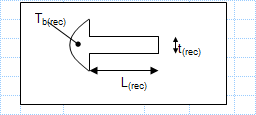Rectangular verses triangular cooling fin effectiveness.xls

Description
KNOWN: Dimensions, base temperature and environmental conditions associated with rectangular and triangular stainless steel fins.
FIND: Efficiency, heat loss per unit width and effectiveness associated with each fin.
ASSUMPTIONS: 1) Steady-state conditions.
2) One-dimensional conduction.
3) Constant properties.
4) Negligible radiation.
5) Uniform convection coefficient.
Calculation Reference
Fundamentals of Heat and Mass Transfer - Frank P. Incropera
To compare the effectiveness, efficiency, and heat loss per unit width of rectangular and triangular cooling fins, you can follow these steps:
-
Determine the dimensions and base temperature: Note the dimensions of the rectangular and triangular stainless steel fins, including the length (L), width (W), thickness (T), and base temperature (T_base). Also, identify the environmental conditions, including the convective heat transfer coefficient (h) and ambient temperature (T_ambient).
-
Calculate the characteristic length: Determine the characteristic length (L_c) for each type of fin using the appropriate formula:
For rectangular fins: L_c = 2W / (W + T)
For triangular fins: L_c = (2 / 3) * W
-
Calculate the fin efficiency: Calculate the fin efficiency (η) for each type of fin using the equation:
η = tanh(m * L_c) / (m * L_c)
Where m is the fin efficiency factor, which is calculated as: m = sqrt((h * P) / (k * A_c))
For rectangular fins, P is the perimeter of the fin cross-section and A_c is the cross-sectional area of the fin. For triangular fins, P is the perimeter of the fin base and A_c is the area of the fin base.
-
Calculate the fin effectiveness: The fin effectiveness (ε) represents the ratio of the actual heat transfer to the maximum possible heat transfer. It can be calculated using the equation:
ε = η * (tanh(m * L) / (m * L))
Where L is the length of the fin.
-
Calculate the heat loss per unit width: The heat loss per unit width (q) can be calculated using the formula:
q = h * (T_base - T_ambient) * ε
-
Repeat steps 2-5 for both the rectangular and triangular fins to obtain their respective efficiency, effectiveness, and heat loss per unit width.
By following these steps, you can compare the efficiency, effectiveness, and heat loss per unit width of rectangular and triangular cooling fins. These parameters provide insights into the performance and effectiveness of the different fin geometries in dissipating heat.
Calculation Preview
Full download access to any calculation is available to users with a paid or awarded subscription (XLC Pro).
Subscriptions are free to contributors to the site, alternatively they can be purchased.
Click here for information on subscriptions.

